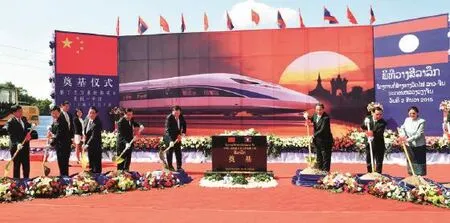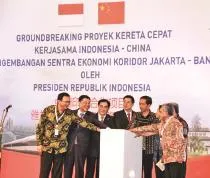BRIEF NEWS
BRIEF NEWS

Chinese President Xi Jinping recently visited Saudi Arabia,Egypt and Iran.
President Xi Visits Saudi Arabia, Egypt, Iran
At the invitation of King Salman bin Abdulaziz Al Saud of Saudi Arabia, Abdel-Fattah al-Sisi, the President of Egypt, and Hassan Rouhani, President of Iran,Chinese President Xi Jinping visited the three countries on January 19-23. The historic and fruitful visit testifies to China's commitment to promoting peace and development around the world and building a new type of international relationship featuring win-win cooperation.
China agreed to upgrade its bilateral ties to a comprehensive strategic partnership with Saudi Arabia and Iran respectively,andsigned a five-year outline document with Egypt to further advance their relationship. President Xi discussed cooperation with the leaders of the three countries within the framework of the Belt and Road Initiative and unveiled cooperation projects promoting industrial capacity, infrastructure,energy, etc.
President Xi also visited the headquarters of the Arab League in Cairo, where he delivered an important speech. He elaborated on China's policy,declaring: "Instead of looking for proxies, China promotes peace talks in the Middle East; instead of seeking sphere of influence, China calls on all nations in the region to take part in the Belt and Road Initiative; and instead of attempting to fill any 'vacuum', China aspires to build a network of mutually beneficial partnerships."
China Boosts Targeted,Discretionary Macro Control
“China would continue to boost targeted and discretionary macro regulation this year within a set range,” Chinese Premier Li Keqiang said at the Fifth Plenary Meeting of the State Council on January 22, 2016.
“China will promote structuralreform, especially supply-side structural reforms, and use fiscal and monetary policies, as well as policies on industry, investment and prices, to create stable conditions for economic growth. It will carry out innovation,coordination, green development,opening up and sharing proposed by the CPC Central Committee in 13th Five-Year Program, the country's road map for social and economic development covering 2016-2020,” the Chinese Premier said.
Premier Li went to say that,at the start of the period, the government faces tough tasks to fulfill the annual targets as many international institutions have lowered their forecasts of global economic growth, while domestic conflicts are growing prominent.
China's Defense and Military Reform
China has taken comprehensive measures to move forward defense and military reform, including downsizing of force levels by 300,000.
On January 11, 2016,the military's four general headquarters of staff, politics,logistics and equipment were restructured into 15 new agencies under the Central Military Commission (CMC), namely,seven departments covering general office, joint staff,political work, logistical support,equipment development,training, and national defense mobilization; three commissions of discipline inspection, politicsand law, and science and technology; and five affiliated institutions of strategic planning,reform and organizational structure, international military cooperation, auditing, and administration.

China conducted the national defense and military reform.
On January 2, three new PLA branches, the Army Headquarters, the Rocket Force and the Strategic Support Force,were established.
President Xi Jinping, also General Secretary of the CPC Central Committee and Chairman of the CMC, described the restructuring as "a breakthrough" and "a crucial step" toward improved integration and efficiency.
Congratulations to Lao Ruling Party New Leader
On January 22, on behalf of the CPC Central Committee and in his own name, Chinese President Xi Jinping sent a congratulatory message to Bounnhang Vorachit, Lao Vice President, on his election as Secretary-General of the Lao ruling People's Revolutionary Party (LPRP) at the 10th National Congress of the LPRP.
Xi said that, since the convening of the 9th National Congress of the LPRP, steady progress had been made in the construction of socialism and the cause of innovation in Laos,under the strong leadership of the LPRP Central Committee, with social harmony and stability, with rapid economic development and with increasing improvement of the people's livelihood.
He expressed the belief that, under the leadership of the Central Committee of the LPRP and its Secretary-General(Bounnhang), the LPRP and the Lao Government would definitely lead the Lao people of all ethnic groups to unite wholeheartedly,actively forge ahead, stick to leadership by the LPRP and the path of socialism, and promote the construction of socialism and the cause of innovation in Laos to greater success on the basisof a new start point.
President Xi stressed that the CPC and the Chinese government have always viewed the relations with their Lao counterparts from a strategic height and from a long-term perspective. The CPC and the Chinese government will adhere to the guidelines of "long-term stability, good neighborliness and friendship, mutual trust and comprehensive cooperation" and the spirit of being "truly good neighbors, good friends, good comrades and good partners".

China, Vietnam Joint Inspection
China-Vietnam to conduct joint inspection on waters outside mouth of Beibu Gulf.
When Chinese President Xi Jinping paid a State visit to Vietnam in November 2015,China and Vietnam agreed in a joint communiqué to launch a China-Vietnam joint inspection of the waters outside Beibu Gulf On December 19, the joint inspection was launched in Guangzhou,Guangdong Province.
A press release from the Chinese Foreign Ministry said the joint inspection showed both countries were committed to solving maritime differencesvia cooperation in an appropriate way. "The two sides can clarify the resources and geology through joint inspection in order to lay a sound foundation for demarcation and joint development of the waters outside the mouth of the gulf," said the press release.

Zhang Dejiang,Chairman of the National People's Congress (NPC)of China,attended the groundbreaking ceremony of China-Laos railway project.
The inspection will be carried out by China's Fendou No 5 ocean research vessel.
China-Vietnam Cross-Border Trade
Trade revenue across China-Vietnam border in 2015 accounted for 85 percent of Vietnam's total border trade revenue, according to the Vietnamese Ministry of Industry and Trade on Jan 5, 2016.
During 2015, Vietnam achieved some US$27.56 billion in border trade with China, Laos and Cambodia, an increase of 27 percent compared to 2014. Import and export commodities via border between Vietnam and China were diverse. Vietnam mainly exports agro-forestryfishery products, minerals,processed and industrial products to China, while importing materials for production, food,consumer goods, machinery,vehicles, and electronic products,among others.
China, Laos, Thailand to Be Connected by Rail
On December 2, 2015, the 427.5-km-long China-Laos railway, from Vientiane to Boten,a project costing 38.7 billion yuan (US$6.04 billion) , broke ground in Vientiane, as part of the celebration of the 40th anniversary of the founding of the Lao People's Democratic Republic. Choummaly Sayasone,Secretary General of the Lao People's Revolutionary Party and President of the Lao People's Democratic Republic, and Mr.Zhang Dejiang, Chairman of the National People's Congress(NPC) of China, attended the ceremony.
Chinese officials said the project would boost cooperation between China and Laos and the region. The Vientiane-Boten line will form part of the regional Kunming-Singapore rail network with a distance of 3,000 km. The rail line will link Kunming, capital of China's Yunnan Province, all the way down to Singapore,passing through Laos, Thailand and Malaysia.
The 1.435-metre standardgauge railway will connect the Chinese rail network with Thailand's planned railway line on their joint border in Nong Khai province via Laos. China's rail cooperation with Thailand was commenced at Chiang Rak Noi in central Thailand on December 19, 2015.

Chinese Trains Operating in Myanmar
On January 18, 2016, two brand new passenger trains set out from Yangon, the capital of Myanmar, and Mandalay,the country's second largest city, marking the beginning of the business operation of China-made passenger trains in Myanmar.

Jakarta-Bandung High-Speed Railway Link
On January 21, 2016,construction started on Indonesia's first high-speed railroad project, a 150km-long line from Jakarta to Bandung. Upon completion in 2019, the railway will be able to transport 44,000 passengers daily, and the travel time between the two cities will be reduced from the current 3-5 hours to under 40 minutes.
The US$5.5 billion project involves PT Kereta Cepat Indonesia-China - a consortium involving Indonesian stateowned companies and China Railway International Company, a subsidiary of China Railway Corp. It is 75-percent financed through a loan provided by the China Development Bank, with the remainder of the funding from the other partners.
CRRC Corporation Ltd., China's largest train manufacturer, has set up a manufacturing base in Malaysia for production, testing,maintenance and refurbishment,with an annual production capacity of 100 electric trains and light railway engines, which will partially meet the rising demand of ASEAN countries for both electric locomotives and commuter trains for city and suburban lines.
China's Cell Phone Internet Surfers
About 620 million Chinese,nearly half of the country's population, had used mobile phones to access the internet as of the end of 2015, according to an official report released by the China Internet Network Information Center (CNNIC) in late January.
Mobile phones have become a major driver of growth in China's internet user population. Around 127 million Chinese access the internet only by cell phone. Internet coverage expansion has helped improve public services, living standards,and e-commerce.
Tourists in Hainan Province
China's island province Hainan sees double-digit growth in tourists and their spending,according to Mr. Sun Ying,Director of the Hainan Tourism Commission on January 24,2016.
Hainan received about 53.36 million tourists in 2015, up 11.4 percent year-on-year. Tourists' spending reached 57.2 billion yuan (about US$8.9 billion), up 13 percent year-on-year.
Source:
Xinhua News Agency,China News Service,China National Radio,China Daily

